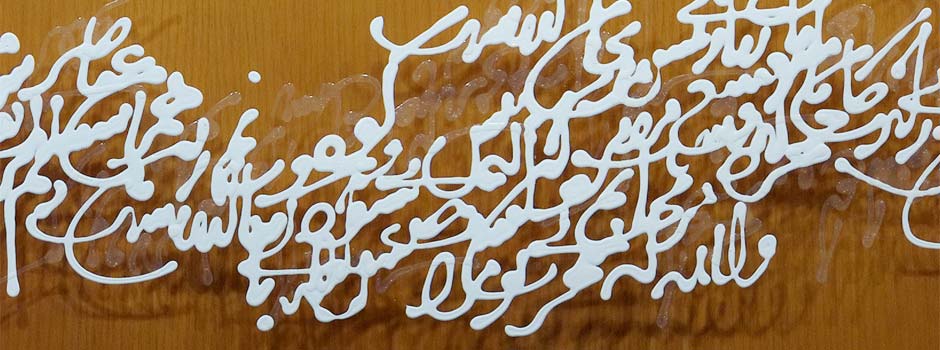
AN INTERVIEW WITH SOHEILA ESFAHANI Working Across Cultures
Jul 06, 2012 Interview
Image above: Soheila Esfahani / Detail, Mapping of a quest, acrylic and pen on Mylar, 2008, 42ft x 30in / Courtesy of the artist
Born in Tehran, Soheila Esfahani moved to Canada with her husband in order to study at the University of Waterloo. Although planning to study architecture, she was so taken by drawing and painting that she decided to pursue a degree and career in the fine arts instead. Preoccupied with issues of cross-cultural translation and identity, her work has, until very recently, chiefly drawn inspiration from Rumi, both textually and visually. Inspired by the medieval mystic’s spiritual poetry proclaiming the universality of mankind, her paintings begin as frenzied transcriptions of his verse, the Farsi calligraphy losing its literal message and meaning as it is transformed into image and abstraction. Although the resulting paintings are beautiful, what seems to count most for Esfahani is the actual process: her canvases embody the event of their making in which the physical and the spiritual lose the duality often ascribed to them. Process has become even more central in her new body of work: installations that feature the industrial shipping pallet, a globally ubiquitous symbol of international migration and transnational exchange. In this series called Trans, Esfahani shifts the emphasis from text to that of context and adopts a more complex view of the possibility or nature of cross-cultural relationships. I sat down with Soheila to find out more about her ideas and art.
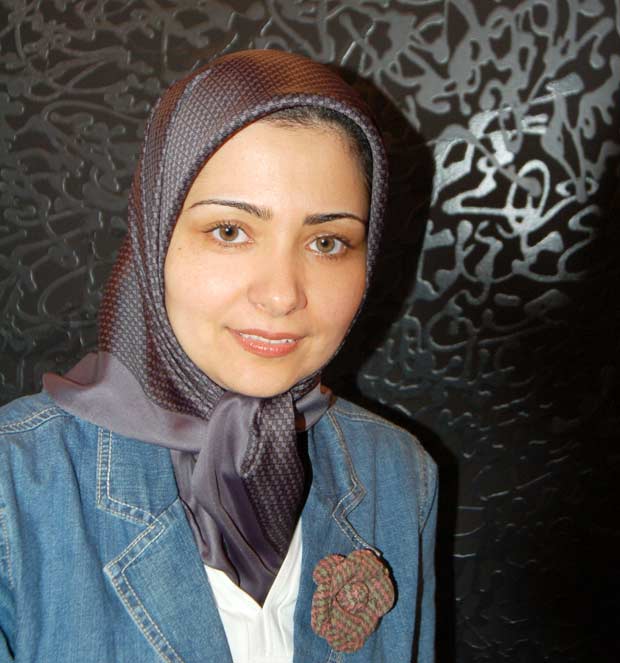 Soheila Esfahani / Courtesy of the artist
Soheila Esfahani / Courtesy of the artist
Artists are creators of concepts and ideas. They are also cultural producers.
I’ve always been interested in working in a creative field. In fact, I started studying architecture in Iran. When I came to Canada, I took fine arts courses to build my portfolio in order to apply to the school of architecture at Waterloo, but eventually decided to stay and finish the visual arts program because I felt that in the end it would provide me with a more creative path than an architecture program.
 Soheila Esfahani / “The Vagireh Patternâ€, Laser-etched wooden shipping pallets, 62â€x48â€x40â€, 2010 / Courtesy of the artist
Soheila Esfahani / “The Vagireh Patternâ€, Laser-etched wooden shipping pallets, 62â€x48â€x40â€, 2010 / Courtesy of the artist
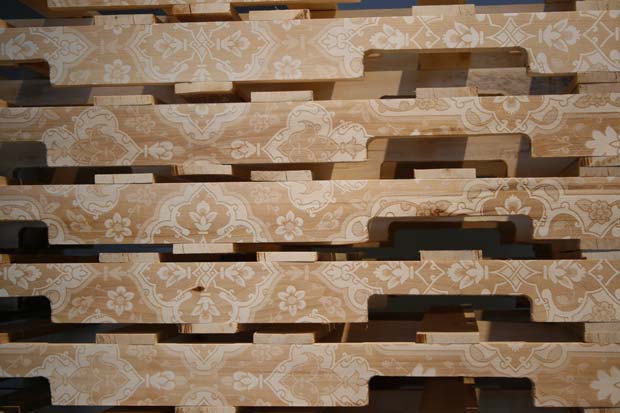 Soheila Esfahani / Detail, “The Vagireh Patternâ€, Laser-etched wooden shipping pallets, 62â€x48â€x40â€, 2010 / Courtesy of the artist
Soheila Esfahani / Detail, “The Vagireh Patternâ€, Laser-etched wooden shipping pallets, 62â€x48â€x40â€, 2010 / Courtesy of the artist
I am indeed a Canadian citizen as well as Iranian citizen. My Canadian citizenships reflects on the choice I made to be part of this very multicultural country. National identities are important to me in terms of their cultural content; otherwise borders are, in my opinion, just geographical divisions. Canada is my home now. It is where I have raised my family, and I have lived here for almost half of my life. However, I still definitely identify with my Iranian roots and culture, but also feel that I am a citizen of the world, even if this is a bit of a utopian idea.
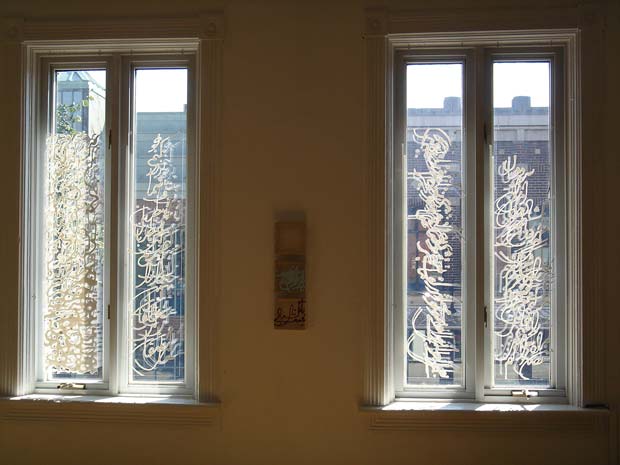 Soheila Esfahani / "Soul I-II, III, IV", Acrylic on plexiglass, 1’x4’, 2005 / Courtesy of the artist
Soheila Esfahani / "Soul I-II, III, IV", Acrylic on plexiglass, 1’x4’, 2005 / Courtesy of the artist
It does come from my roots which are intertwined with Islamic culture. However, I am not consciously creating Islamic art. I would say mysticism comes to play in my work because of using Rumi’s writings.
I’m not familiar with 'the hurufiyya movement' because of my western art education. I was drawn to calligraphy because of its abstract linear qualities. However, I am referring to the long tradition of calligraphy in which it functioned both as a fine art and as a decorative one, adorning mosques for example.
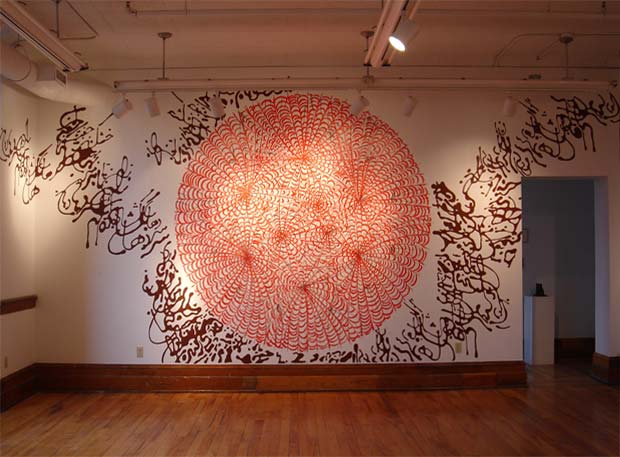 "Opus S" / Collaboration by Soheila Esfahani & Fatima Garzan
"Opus S" / Collaboration by Soheila Esfahani & Fatima Garzan
I have always been drawn to Rumi because I found his poems and teachings to have universality. You are right in the sense that my work is not a critique; rather I hope to reach as wide an audience as possible.
Yes, but in the context of Canadian culture, I don’t feel that 9/11 has created a negative impact on the reception of my work or similar work.
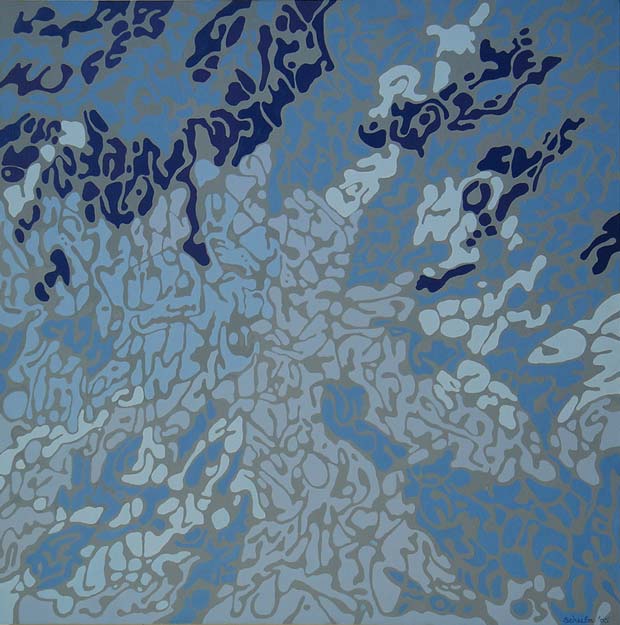 Soheila Esfahani / "Reed Bed", Oil on canvas, 2005 / Courtesy of the artist
Soheila Esfahani / "Reed Bed", Oil on canvas, 2005 / Courtesy of the artist
As you said my Persian heritage brings a particular or specific cultural component to my art. As for my Canadian part, it brings to my work the language of western contemporary art such as abstraction, although I must add that modernism now has a pretty long history of its own in the Middle East. So maybe it would be more accurate to say that the Canadian part of my identity actually emphasizes and makes me more conscious of the cultural specificity of my work which may have not been as apparent if I were working as an artist in Iran. I see myself as a culturally diverse artist in West.
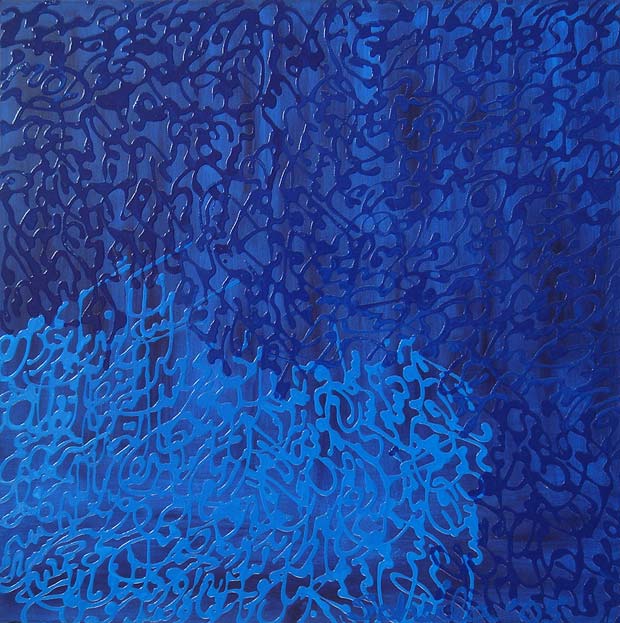 Soheila Esfahani / "Reed Flute III", Acrylic on Canvas, 3’x3’, 2005 / Courtesy of the artist
Soheila Esfahani / "Reed Flute III", Acrylic on Canvas, 3’x3’, 2005 / Courtesy of the artist
With this piece, I had people making connections to aboriginal art in Canada which probably would not be the case within an Iranian context. I haven’t exhibited my work in Middle East, but I would speculate that my work would be received, as you suggested, as Middle Eastern modern or contemporary art.
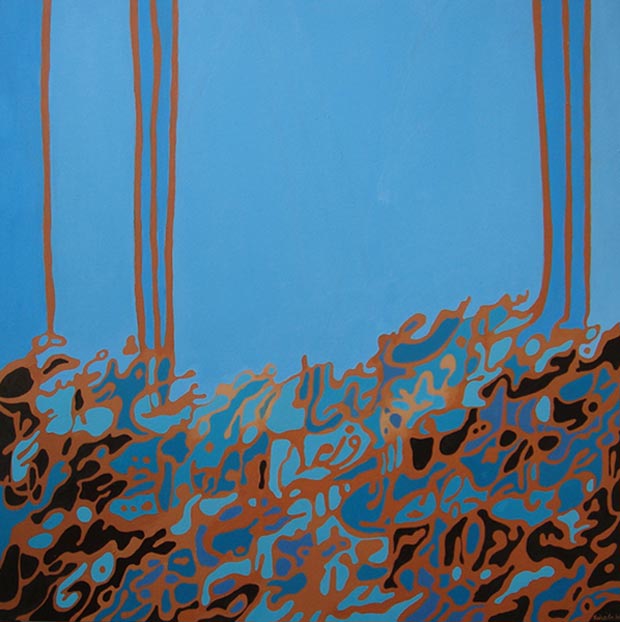 Soheila Esfahani / "Reed Bed II", Oil on canvas, 3’x3’, 2006 / Courtesy of the artist
Soheila Esfahani / "Reed Bed II", Oil on canvas, 3’x3’, 2006 / Courtesy of the artist
For my paintings, I use acrylic paint because of its fast drying time. Acrylic paint works well with my technique of squeezing a mixture of paint and medium on canvas because of its fluidity and fast drying time. Although I make ‘paintings’, I see them more of conceptual art than traditional genre of painting. That’s possibly why I have shifted my practice to installation in recent years.
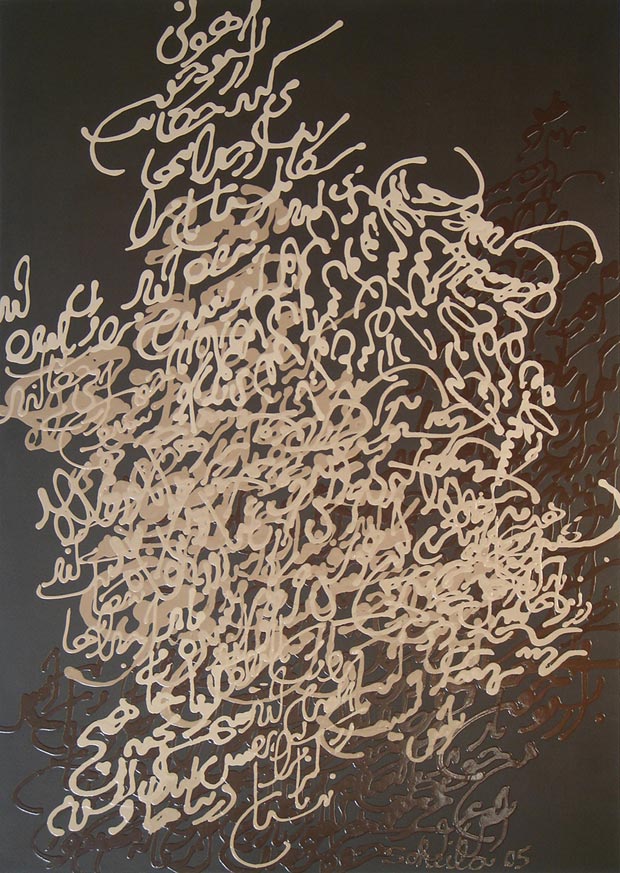 Soheila Esfahani / "Longing II", Acrylic on canvas, 6.5’x 4.5’, 2005 / Courtesy of the artist
Soheila Esfahani / "Longing II", Acrylic on canvas, 6.5’x 4.5’, 2005 / Courtesy of the artist
In my paintings, the specific Rumi poems that serve as inspiration and starting point are obviously related to my personal state of mind at a given moment or period of life. For example, in my first series "Poetic Compositions", I was drawn to the verse "Lovers, oh, lovers, I shall turn your dust into gold," since I felt connected to the idea of transformation into something higher. As an artist we use materials and substances, but try to transform them into concepts and meanings, which is ‘gold’. At the time of the "Reed Flute" series, I was feeling disconnected to my Persian roots because of living in Canada. So the work speaks of trying to go back and find your source. My most recent piece, Made in Iran, is a series of artifacts that involve various designs that I have a personal connection to. The designs include graffiti from the garbage bin by the bus stop in London where I would take the bus back home to Waterloo during my MFA studies at the University of Western Ontario, a William Morris wall paper design appropriated from a greeting card my brother sent me for the Persian new year, an 'Amir Lebanese fast food' logo that my friends brought back from their trip to Montreal, and so on. So, you see, the two, art and life, are in my case very related to each other.
I exhibit my work mostly in North America. I would be interested in exhibiting in the Middle East if the opportunity arises. I situate my work as culturally diverse art in the West.
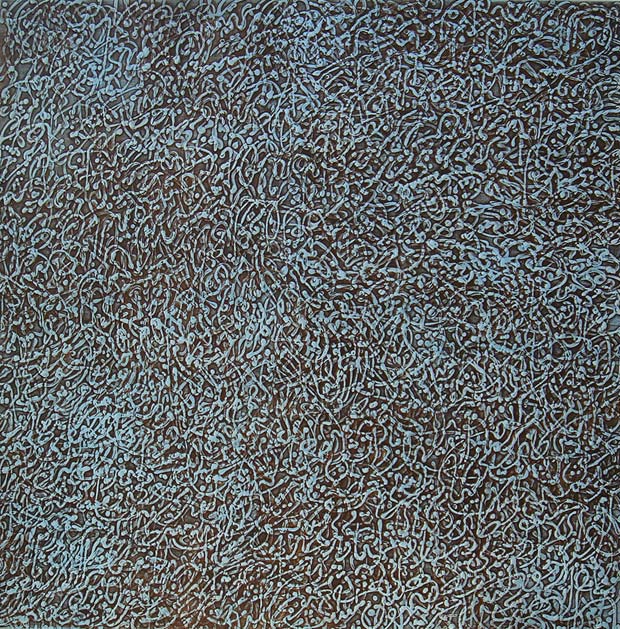 Soheila Esfahani / "Longing I", acrylic on canvas, 4'x4', 2005 / Courtesy of the artist
Soheila Esfahani / "Longing I", acrylic on canvas, 4'x4', 2005 / Courtesy of the artist
I don’t think there is less emphasis on aesthetics or on beauty. From my perspective, they are both highly aesthetic works. In Made in Iran the pieces were hand made by my aunt in Iran in a traditional craft form of moaragh, which is a traditional craft of marquetry, the hand cutting intricate designs into various kinds of wood. But nonetheless I have to say yes, I’m questioning the notion of authenticity. My present work wants to probe questions such as: Does producing these designs in a traditional craft make them become more culturally specific? Or do they now speak to something ‘new’ and operate in the ‘third space’? With this new series, I’m trying to develop a new language that moves beyond the opposition usually set up between the West and the East because this is the reality of my life.
To see more of her work visit our ONLINE GALLERY.
Comments
Add a comment